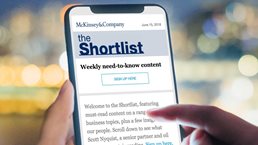For retailers seeking to cut costs and generate cash for growth investments, indirect spending can be a big untapped opportunity. Indirect costs—the goods and services that retailers purchase but don’t resell—are equivalent to 10 to 15 percent of sales on average, and most retailers know that their indirect spending is far from optimized. But while recognizing the potential is easy, capturing it has proven stubbornly difficult.
The challenges aren’t new. They include a lack of spending visibility, fragmented ownership and spend authority, a dearth of incentives to reduce indirect spend, and a siloed approach to procurement of not-for-resale (NFR) categories. In addition, indirect procurement typically focuses on negotiations with suppliers over price, rather than on higher-impact opportunities to optimize what and how the retailer buys. Our research has also shown that capabilities and resourcing for NFR procurement in retail are significantly weaker than in many other sectors: NFR goods and services are viewed as much less important than goods for resale, so the NFR sourcing staff tends to receive less management attention and less investment in talent. Furthermore, even NFR sourcing professionals typically have little expertise in NFR categories. Rare is the procurement team that has deep knowledge of, say, elevator maintenance or marketing-agency overhead costs.
Visionary retailers, however, are taking a radical new approach to indirect spending—and achieving radical results. These retailers aren’t viewing indirect costs as a concern only for the procurement function. Instead, they’re looking to transform indirect spending across the entire business. They’re overcoming the challenges by leveraging three new ways of working: a cross-functional approach that incorporates category-specific demand levers, the use of digital and analytical tools, and stronger supplier collaboration. And they’re taking specific actions to bring about lasting change in mind-sets and behaviors.
In doing so, retailers are shaving as much as 10 to 15 percent off their annual indirect spend, capturing impact worth 1 to 2 percent in return on sales, and seeing a more than fifteen-fold return on the cost of their NFR sourcing team. We’ve found that the value at stake is remarkably consistent across retailers—even at those that have been working on reducing indirect costs for a long time, whether in-house or with external support.
A business transformation
To capture maximum value from a cost-reduction program, retailers must be deliberate about the program’s scope and ambition level. A broad scope and high targets are indispensable elements of a truly transformative effort.
Historically, retailers have cut costs primarily by reducing labor costs in their stores or head office. Few retailers have tapped into the full potential of optimizing NFR spending (Exhibit 1). Furthermore, even retailers explicitly seeking to reduce indirect spending sometimes ring-fence certain cost categories as “not addressable.” For instance, some retailers consider marketing expenditures out of scope; their rationale is that marketing is critical to the core business of retail. Other retailers don’t bother trying to lower rents, because they assume that they can’t renegotiate terms unless they’re in financial distress. Some indirect costs—such as supplier-managed logistics—remain unchallenged because they’re “hidden” in cost of goods sold. And some retailers look for cost-reduction opportunities only in operating expenses, leaving all capital expenditures untouched—even though the latter often has higher savings potential (as a percentage of costs).

In bypassing these categories, retailers are forfeiting more than half of the potential impact and missing out on the synergies that a large-scale program could bring. To achieve transformative change in indirect spending, there can be no sacred cows.
Another must-do for a transformation program: set stretch targets that inspire creativity and out-of-the-box thinking. To set its NFR targets, one retailer first conducted a fact-based diagnostic that was championed by senior leaders. This exercise helped the organization understand that the program was a priority, adopt a transformational rather than an incremental mind-set, and focus on how to achieve the targets rather than on trying to change them.
New ways of working
Seeing an NFR effort as a business transformation is a crucial first step. To maximize NFR savings, retailers then need to adopt three new ways of working.
A cross-functional approach incorporating category-specific demand levers
Transformation of indirect spend will require the involvement and commitment of more than just the procurement staff. A cross-functional team can break down silos, pose tough questions about what the business really needs, and make balanced trade-offs.
A cross-functional team can pull the basic supplier-management levers (such as competitive bids and supplier consolidation) that affect who the retailer buys from and at what price. The team can also pull process-management levers, which influence how a retailer buys: if the various functions comply with procurement policies and use only preferred vendors, maverick spending will be reduced or even eliminated. Savings across the organization can be more easily tracked. The retailer can better negotiate vendor payment terms and cycles to its benefit.
Most importantly, a cross-functional team will be better placed to pull category-specific demand-management levers, which influence what the retailer buys. In our experience, these levers deliver as much as half of the potential savings—or even more for mature companies, because negotiating for lower prices yields diminishing returns over time. The biggest opportunities are often in areas that many retailers consider out of scope, such as marketing (by using a return-on-investment approach, for instance) or logistics (using levers such as inventory reduction or network redesign).
Would you like to learn more about our Retail Practice?
A retailer, seeking to optimize logistics spending, tasked a cross-functional team with redesigning its distribution network. The team was able to reduce end-to-end costs by selectively increasing certain logistics costs. For example, it switched some deliveries from sea to air in order to gain sales and reduce markdowns. It also increased delivery frequency for some products and stores while decreasing it for others.
The use of digital and analytical tools
Digitization has revolutionized every business process and will continue to do so; indirect sourcing is no exception. Today, leading retailers are using digital and analytical tools in the following areas to achieve dramatic reductions in indirect costs:
- Spend visibility. Advanced digital solutions, powered by artificial intelligence (AI) and machine learning, enable retailers to rapidly and accurately map the relevant spend base into granular categories, shedding light on exactly who spends how much on what. Cutting-edge digital procurement solutions can pull purchase-order (PO) and invoice data from multiple systems to create a “spend cube,” automatically generating benchmarks on pricing and specs, as well as dashboards and reports to help category managers monitor spending. One retailer had recently streamlined its headquarters organization but found through AI-supported spend mapping that many of the costs had crept back in through the use of contractors and temporary labor. Once the retailer generated the spend cube using an agreed taxonomy, it could lock down a baseline and see how much it was spending on contracted versus uncontracted vendors.
- Consumer insights. A retailer used digital consumer surveys and crowdsourced competitor benchmarks to understand, address, and retest consumer perceptions of store cleanliness. Which areas of the store did consumers notice most? Which areas did they hardly notice at all? Analysis showed that the parking lot and the sidewalks were perceived as clean enough, so instead of hiring a cleaner to do a thorough cleaning multiple times a day, the retailer cut back to once a day, with store associates doing spot checks every few hours. The surveys also revealed places—such as fitting rooms and the shoe department—where the retailer could invest in more frequent cleaning to boost customer satisfaction. The business-insights team then measured the exact impact of these adjustments on the retailer’s sales.
- Design to value. A retailer reduced the cost of its paper shopping bags by 25 percent by redesigning them. Through digital analysis of basket size, product dimensions, and data from cashier surveys, the retailer determined the ideal dimensions of a shopping bag based on the distribution of physical volume and weight of products. Further digital analysis—along with input from cashiers, baggers, and vendors—helped the retailer arrive at the substrate composition that would give the shopping bags the right levels of puncture strength and tensile strength.
- Clean sheeting. Digital clean-sheeting tools can reduce indirect costs by as much as 40 percent in a category. Such tools typically feature algorithms for determining costs in various NFR areas, dynamic databases of input costs (such as raw-material index prices), and a sophisticated calculation engine. Through a clean-sheeting exercise, one retailer discovered that it was paying much more than the “should cost” for store shelves (Exhibit 2).
- Spend control. Digital procure-to-pay tools give retailers better spend control by enforcing more discipline in how suppliers are set up and approved, and by supporting a more rigorous PO-approval process.
- Zero-based budgeting (ZBB). Using digital tools (and enabled by increased spend visibility), retailers can easily build detailed bottom-up budgets, detect the exact drivers of variances, and take swift action to close gaps. ZBB, which first gained traction in consumer-goods companies, can be powerful for retailers, especially in store-related NFR categories. Determining the appropriate budget for each store, and then tracking adherence to that budget, can yield significant savings.

Closer collaboration with suppliers
Retailers should work with suppliers on cost improvements and innovations. Suppliers can be great idea generators because they know a retailer’s bad habits better than the retailer itself does and would rather help change those habits than lose the business. Retailers can also invest in improving supplier capabilities in ways that will pay the investment back several times over. Among the benefits of stronger supplier relationships: better product quality and availability, faster responses to market needs, less administrative effort, greater efficiency, and lower total cost.
The elements of successful supplier collaboration include focusing on a limited number of suppliers to deliver the highest return on investment, establishing a robust value-sharing agreement at the outset, creating a dedicated supplier-collaboration team separate from but aligned with category managers, and building a disciplined performance-management and benefits-tracking system.
One retailer, when retendering its contracts for outsourced warehousing, required suppliers to submit proposals for improving the joint warehousing operation. Based partly on these proposals, the retailer reduced its supplier count to two, allowing for closer collaboration while maintaining some competitive tension. The retailer built continuous-improvement targets into the contracts, with gainsharing incentives for the suppliers. It also invested in a “lean warehousing” team that works closely with the suppliers to build capabilities.
Getting it done
Retailers must embed these new ways of working into daily tasks. To sustain behavioral change, they must then use all four parts of the “influence model” (Exhibit 3).

Fostering understanding and conviction
Leading retailers lay out a clear case for change and help each stakeholder connect to it on a personal level. An important aspect of the change story is communicating why savings are needed and what they will be used for. Allowing business units or functions to reinvest part of the savings can increase motivation. (One initiative leader at a retailer put it this way: “Half goes to the CFO, but the other half we get to keep.”) The head office should, of course, have enough visibility into the reinvestments to ensure they align with corporate priorities and generate strong returns.
Intelligent target setting also helps foster understanding across the organization. Targets should be based on detailed diagnostics, including benchmarking against a relevant peer set. Otherwise, stakeholders will reject the targets as arbitrary; there’s also a risk of damaging the business by pushing it into “slash and burn” cost cutting. The diagnostics should yield not just a single target—say, $100 million in cost savings—but also a set of quantified initiatives. Targets should include cost ratios (for example, logistics spending as a percent of sales) rather than just absolute numbers, to ensure that cost efficiency genuinely improves even when the category experiences tailwinds. (For example, a decline in logistics costs due to a decline in sales isn’t really an improvement.)
Because indirect sourcing is typically perceived as a backwater and procurement staff can feel they’re performing thankless work, external visibility can be highly motivating. When retail CEOs publicize their NFR initiatives and targets, the people involved in the initiatives see that their work matters and even has the power to influence their company’s stock price.
Along the NFR journey, there will be times when stakeholders resist change for fear of negatively affecting sales. A test-and-learn culture can overcome this. A first step can be to show mock-ups or samples of proposed changes. One retailer’s procurement team recommended using thinner, cheaper paper for marketing materials. It overcame resistance from the marketing department by having samples printed on the thinner paper and using blind testing to demonstrate that the materials were just as effective.
Reinforcing with formal mechanisms
Company goals should be translated into personal targets. One retailer created a simple time line of when initiatives were expected to deliver impact, using the top end of the impact range estimated for each initiative. The resulting quarterly figures became targets for the relevant executives, whose bonuses were partly dependent on hitting those targets.
To follow up on progress against targets, many retailers instinctively go for a monthly cadence of follow-up meetings. But, in our experience, a weekly program-management rhythm is much more effective for driving the pace of initiatives and bringing about cultural change. During the weekly meeting, the team reviews all initiatives but focuses on only a few, either on a rotating basis or to help those that need additional support.

Subscribe to the Shortlist
McKinsey’s new weekly newsletter, featuring must-read content on a range of topics, every Friday
Initiatives should be tracked not only against milestones but also on progression through “implementation levels”: an initiative begins as an idea, matures to a business case, becomes an approved decision, gets implemented, and is ultimately converted to “money in the bank.” The expected impact of initiatives can be appropriately “discounted” when they are in earlier stages. Implementation-level tracking gives the program leader and steering committee a more accurate picture of when impact will be delivered and which initiatives need what kind of support. Linking this tracking to ongoing budgeting, forecasting, and performance-management processes yields greater transparency in profit-and-loss performance.
Developing talent and skills
An NFR program needs a capable program leader and a supporting team. The program leader, who will likely come from a line role, should know the business well and have the respect of top management. Given this individual’s talent and leadership skills, it won’t be an easy decision for senior executives to free him or her up to lead the program. But the sacrifice will pay off.
Still, without sufficient resources for each initiative, the program will struggle. Colleagues from each function or cost category will need to dedicate 10 to 20 percent of their time to the effort. For one $10 billion retailer, delivering $200 million in savings required a program leader and about 40 full-time equivalents (FTEs) working for 12 months. Company leadership had to stop or pause other initiatives to create the required capacity. While 40 FTEs might sound like an enormous investment, the retailer recouped the cost of those employees’ yearlong efforts about 50 times over in recurring savings.
Neither the program leader nor the team members can be expected to have all the relevant category-specific expertise. Our research shows that retailers have eight times the indirect spend per procurement professional compared to other sectors, which means their level of expertise in any particular category will be relatively shallow. Therefore, tapping into internal and external category experts is crucial. One grocery retailer discovered that one of its project managers had been a refrigeration engineer for 25 years. The company brought him into a team tasked with reducing the life-cycle cost of refrigeration, heating, and cooling assets by 30 percent in two years. The team achieved the goal in six months and did so with simple solutions—for example, changing the type of price tags used in refrigerated shelves so that the tags wouldn’t fall off and clog the drain. This change saved the retailer more than $600,000 a year.
Capability building is also key. The best companies use a combination of classroom training, e-learning tools, and on-the-job coaching. In our experience, many NFR professionals who receive functional and category-specific training and mentoring immediately double or triple their effectiveness. A phased train-the-trainer approach—in which the sourcing team receives training during a pilot phase, applies the learnings to an initial set of categories, then trains others in the next phase—has proven effective in many cases.
Role modeling
The CEO, CFO, and the rest of the management team must work together to communicate the case for change and role model the desired mind-sets and behaviors. Working as a cross-functional steering committee, they can remove roadblocks, surface and capture cross-functional opportunities, and allocate enough resources to them, thereby sending an unmistakable message to the organization about the importance of these initiatives.
Another powerful role-modeling lever is senior sponsorship of initiatives. Senior leaders can serve as coaches for the owners of individual category initiatives, whether those owners are within or outside the senior leaders’ respective functions.
Helping to secure—and then celebrate—early wins is also a form of role modeling. It lets the entire organization see that senior leaders are committed to ensuring the NFR program’s success and that they recognize its impact.
Most retailers have significant opportunities to reduce indirect costs. The first step is to acknowledge that the potential exists, then conduct a thorough diagnostic to quantify it. Though challenging, a transformation in indirect spending can yield greater profitability, funding for growth, and competitive advantage.


